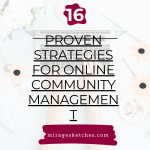Introduction
Online communities are an important aspect of our digital lives. They offer a platform for people to connect, exchange ideas and opinions, and engage in meaningful discussions.
However, managing an online community can be challenging, especially when maintaining a safe and secure environment for its members.
Community moderation is enforcing rules and policies to ensure the online community is a safe and secure place for its members.
It is an ongoing task that requires the support of both community moderators and members.
In this article, we’ll discuss the best practices for community moderation so that you can build and maintain a thriving online community.
Define Your Community Guidelines
Defining your guidelines is the first step in creating a safe and secure online community. These guidelines should clearly outline the acceptable expectations and behaviours within the community.
This can include topics such as harassment, hate speech, and spam.
It is important to ensure that your guidelines are clear, concise, and easily accessible to all members.
Providing examples of unacceptable behaviour can help ensure that everyone understands what is expected of them.
Use Automated Tools
Automated tools can help the moderation process by detecting and flagging potential violations.
Tools such as content filters and keyword blockers can be useful in detecting and removing inappropriate content.
However, it’s important to remember that these tools are imperfect and should be used with human moderators.
This will ensure that any potential violations are reviewed by a human rather than simply being automatically removed.
Engage Your Members
Engaging your members is an important aspect of community moderation.
Encouraging members to report any violations they see and involving them in the moderation process can help create a sense of ownership and responsibility within the community.
It is also important to listen to the feedback and concerns of your members.
Responding promptly and professionally to their comments and concerns can help build trust and foster a positive relationship between the community and its moderators.
Monitor User Behavior
Monitoring user behaviour is an important part of the moderation process.
This can be done through tools such as activity logs and analytics, which can help identify patterns of behaviour that may require further attention.
It’s also important to regularly review user profiles and activity to ensure they align with your community guidelines.
This can help prevent potential violations and maintain a safe and secure environment for your members.
Be Consistent
Consistency is key in community moderation. It is important to enforce your guidelines consistently and fairly across all members, regardless of their status within the community.
This will help ensure everyone understands and respects the rules and help maintain a safe and secure environment.
Provide Clear Consequences
Ensuring that the consequences of violating community guidelines are clearly communicated to all members is important.
This can help ensure everyone understands what will happen if they engage in unacceptable behaviour.
Having clear consequences in place can also serve as a deterrent, as members will be aware of the potential consequences of their actions.
This can help maintain a safe and secure environment for everyone.
Train Your Moderators
Moderators play a crucial role in maintaining a safe and secure online community.
Providing them with the necessary training and resources to carry out their role effectively is important.
This can include training on community guidelines, handling sensitive situations, and using moderation tools effectively.
Providing your moderators with the support they need will help ensure they can effectively carry out their roles and maintain a safe and secure environment for your members.
Foster a Positive and Inclusive Environment
Creating a positive and inclusive environment is important for building a thriving online community.
Encouraging members to be respectful and considerate of each other can help foster a positive and supportive atmosphere.
It is also important to be aware of the potential impact of your language and actions on other members.
Using inclusive language and avoiding insensitive comments can help create a welcoming and inclusive environment.
Regularly Review and Update Your Guidelines
Community moderation is an ongoing process, and it is important to review and update your community guidelines as needed regularly.
This can help ensure that your guidelines are relevant and up-to-date and help maintain a safe and secure environment for your members.
It is also important to seek feedback from your members and make changes based on their suggestions and concerns.
This can help ensure that your guidelines accurately reflect the needs and concerns of your community.
Encourage Self-Moderation
Encouraging self-moderation within the community can help reduce the burden on moderators and create a sense of ownership and responsibility among members.
This can include encouraging members to report violations and behave respectfully and respectfully.
By fostering a culture of self-moderation, members will feel empowered to help maintain a safe and secure environment for everyone.
Conclusion
Community moderation is crucial to maintaining a safe and secure online community.
Following these best practices can create and maintain a thriving online community where members feel comfortable and engaged.
Remember, community moderation is an ongoing process that requires the support and involvement of both moderators and members.
By working together, you can create a safe and secure online community where everyone can connect and engage in meaningful discussions.





